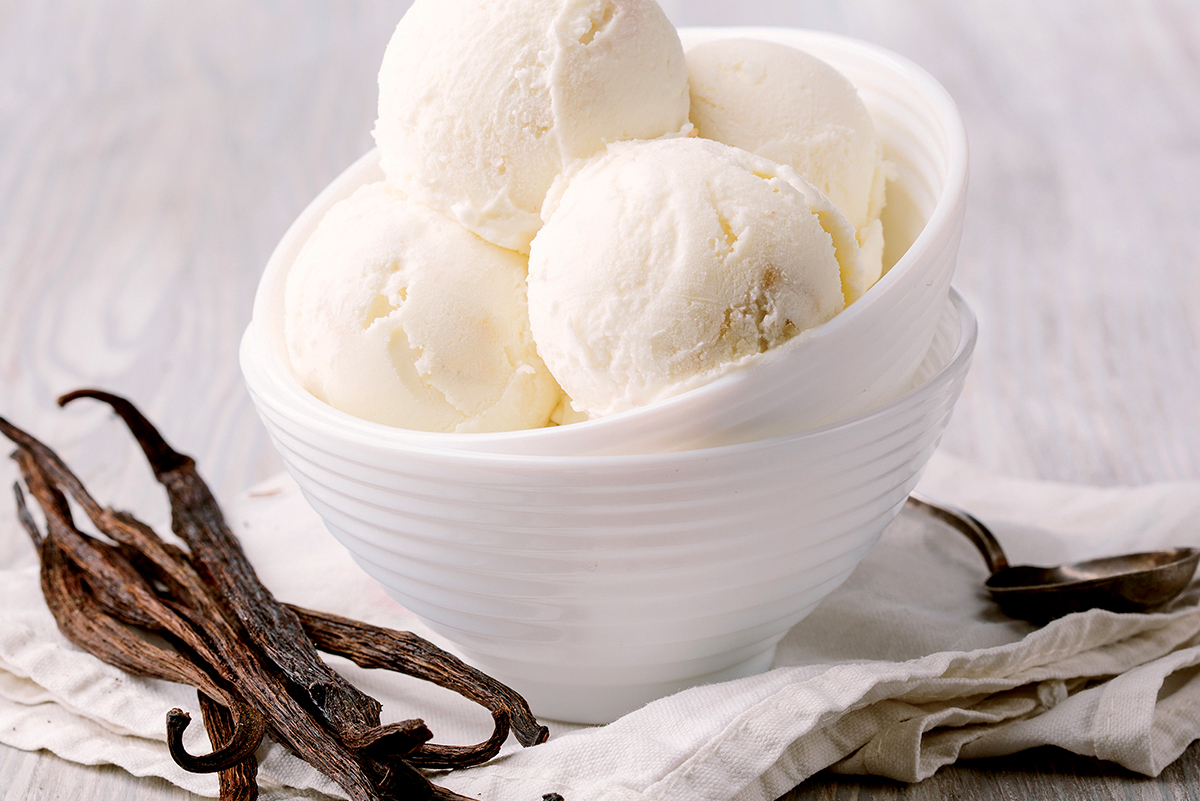You Are What You Eat
The Truth About Vanilla

Vanilla is a very popular flavoring, commonly used in both food and drink. It can be found in a variety of sweet treats, including yogurt, coffee, and smoothies, as well as some savory dishes, such as pasta sauces, vinaigrettes, and certain soups and stews. And of course, vanilla is found in the ever-popular summer staple – ice cream. In fact, vanilla is in every flavor that we ice cream makers make.
What exactly is vanilla, you ask? Encyclopedia Britannica defines vanilla as “any member of a group of tropical climbing orchids and the flavoring extracted from their pods.” Originally found in the eastern jungles of Mexico, vanilla has been used for centuries. The original chocolate drink known as Xocoatl was flavored with vanilla well before the Spaniards drank it in Montezuma’s court. Now, we use vanilla (or eat it) on a daily basis.
The most common form found in grocery stores is vanilla extract arisen from a simple process. Vanilla beans, or pods, are suspended in an alcohol at the rate of one pound of beans per one gallon of alcohol. Three months later … bing bang boom, you have vanilla extract.
As you wander through the grocery store looking at the many vanilla extract options, you may find yourself shocked at their price tags. And you may find yourself wondering why something so simply created is so costly. The answer? Vanilla beans are hard to grow.
Naturally, vanilla is only pollinated by the vanilla bee, which has had a hard time surviving. Deforestation and encroachment on their habitat have reduced the vanilla bee population. As a result, vanilla farmers have begun hand pollinating. This, along with additional issues such as weather and cartels, has resulted in the price of vanilla skyrocketing. When I first started making my own vanilla, beans were sold for $45 a pound. Today, they range from $280 up to $500 a pound, depending on their country of origin and their quality. People with good intentions and a “value” mindset have been making “non-bean,” if you will, flavors for years. Some are natural, some are not.
There are three types of artificial vanilla. One is made from petrochemicals (yes, you read that right) – chemicals (something called “guaiacol”) made from petroleum! I don’t need to go any further other than to say this version is probably not ideal for consumption. The second type is made by extracting “vanilla crystals” from plant-based sources, with yeast and wood pulp being the top culprits in this process. When it comes to discussing both the petrochemical and “crystal” processes, I am not very well-versed (but while I may not be a chemist, I do know enough to be certain that neither of these products are exactly good for human wellbeing). The third type of artificial vanilla brings me to the funny – and perhaps a little bit gross – part of my story …
It begins with one of the world’s greatest engineers that also happens to be one of the world’s cutest inhabitants, as well as a North American resident that is both a prized resource and a pesky nuisance. I’m talking about the beaver. Located between the pelvis and the base of a beaver’s tail are organs called castor sacs. The “goo” that comes from said castor sacs is known as castoreum – what the beaver uses to “mark its territory.” Somehow, because of the beaver’s diet of leaves and trees, castoreum smells and apparently tastes like vanilla. I personally would like to know who the first person was to lift a beaver’s tail, take a big sniff, and decide it would taste great in his pancakes! Although it is approved by the FDA, castoreum is often a combination of castoreum and urine (due to the location of the sacs and the method used to extract it). Here’s one of my favorite jokes, “You can have real vanilla or beaver’s butts – you pick ...”
In all reality, it’s not funny. After reading the aforementioned methods of how artificial vanilla is made, I hope you remember how important it is to think about what you eat, what you buy to eat, and where you go to eat. With the season’s temperatures blazing, you are likely finding yourself craving the sweet refreshing coolness of a delicious scoop of ice cream right about now. If you are looking for a fun summertime activity to enjoy with the kids that will let you beat the heat at the same time, why not make some homemade ice cream? Just remember that when it comes buying vanilla extract for it, ask questions and read labels first. One of the misleading terms is “natural” flavorings – for this sweet treat ingredient, that could be yeast, wood pulp, petrochemicals, or beaver butt goo.
If you can’t find, or trust that what you do find, is true vanilla extract, stop by Lumpy’s, where they make their own vanilla extract using a blend of Mexican and Madagascar vanilla beans. You can also enjoy their fresh vanilla ice cream, as well as their many other unique, fresh, all-natural flavors. In addition, you can find Lumpy’s online at lumpysicecream.com, on Facebook (LumpysIceCream), and on Instagram (thelumpysicecream).
Buck Buchanan
Owner of Lumpy's Ice Cream. Lumpy's uses the finest local ingredients and crafts them into ice cream without any preservatives, additives, or synthetic hormones.

